2020.12.04 | By Gregory Nagy
§0. In the title of this essay, the wording ‘sweet bird’ echoes what we hear in part of a poem by John Milton, Il Penseroso (1645/1646), later set to music by George Frideric Handel (1740), whose librettist merged the poem with Milton’s symmetrical L’Allegro (1645). So, Milton’s poetry became for Handel an extended song blending the mirth of L’Allegro with the melancholy of Il Penseroso. The part of Handel’s sung version that centers on the ‘sweet bird’—and I will quote the words at a later point—is an aria that imitates birdsong by way of a female soprano voice accompanied by a baroque flute. The bird in this English-language song is evidently a nightingale, and it is a ‘she’. What I find remarkable about this nightingale is that she is not only the subject of the song but also the model performer of the song, since the music of what is being sung is ostentatiously modeled on her birdsong. And what I will now argue is that something comparable is happening in the songs of Sappho. Here too we will see a kind of bird—in this case, it is a ‘he’—who is figured both as the subject of song and as a model for singing the song. In this case, however, a question arises: is the ‘sweet bird’ of Sappho, highlighted in the title of my essay, really ‘sweet’ like the pensive and melancholy ‘sweet bird’ of Milton’s poetry turned into song? I will argue that Sappho’s ‘sweet bird’ really is ‘sweet’, yes, though he is also quite mirthful and joyous, like the character by the name of L’Allegro, who is symmetrical with the character named Il Penseroso in the music of Handel. Like L’Allegro, Sappho’s bird takes joy in both pastoral and urban settings. In both settings, he is not only mirthful and joyous: he is even spicy or saucy. Before we consider the famous reference to such a ‘sweet bird’ in one of Sappho’s songs, however, I will first look at relevant references in classical Athenian vase paintings.
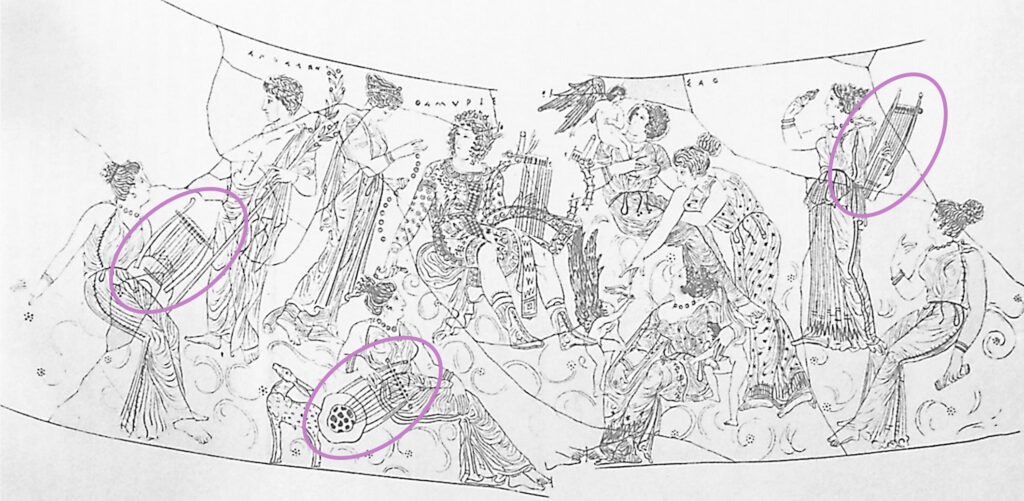
§1. My introductory illustration, shown immediately above, is most relevant. We see here a rollout line-drawing of the overall picture painted on what I have been calling in previous essays the Thamyris Vase, attributed to the Meidias Painter. I have already shown this picture before, in a previous essay about references to Sappho’s songs in Athenian vase paintings, but now I show it again with an added detail: I now highlight, by way of three pink circles, the picturing of three lyres handled by three female beauties who are part of an overall scene centering on the mythical lyre-singer Thamyris, who is seen handling his own lyre. My question of the moment about the overall scene in this “zoom-out” picture is this: if the three female beauties handling their lyres could actually be heard in the act of playing their musical instruments in accompaniment of a song, would we expect such a song to be mirthful and joyous—even spicy or saucy? I could ask the same question about an audio-video song, “Addicted to Love,” sung by Robert Palmer (1985) to the accompaniment of female beauties who are seen and heard in the act of playing their guitars. I now show a line-drawing that pictures in a freeze-frame a moment in the performance of this song, and, in the picture, the three guitars handled by the three female beauties are highlighted by way of three pink circles:

The solo singing is by Palmer, who also composed the song. For a brief documentary of what happened, in later phases of their lives, to the female beauties who are represented as accompanying Palmer’s singing in this video-audio, I recommend this video. For a “ladies only” edition, I cite this video.
§2. Returning to the overall painting of the Meidias Painter on the Thamyris Vase, I focus again on the three female beauties handling their lyres. I argue that they too, like Robert Palmer’s “girls,” could be described as saucy. A telling sign, if we “zoom in” and focus on a detail in the overall picture, is a fluttering little bird that is being passed from one fingertip to another. I have shown that detail in the previous essay that I have already cited, and I return to it now:
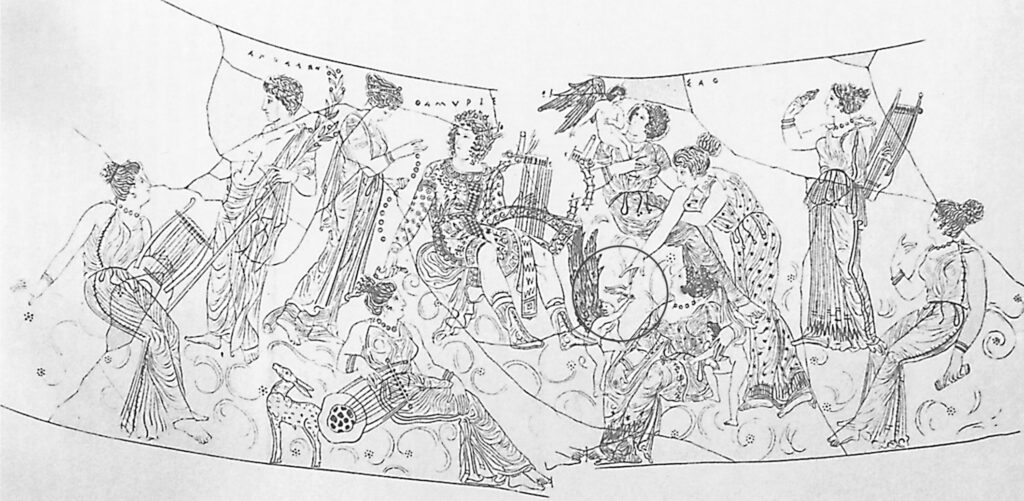
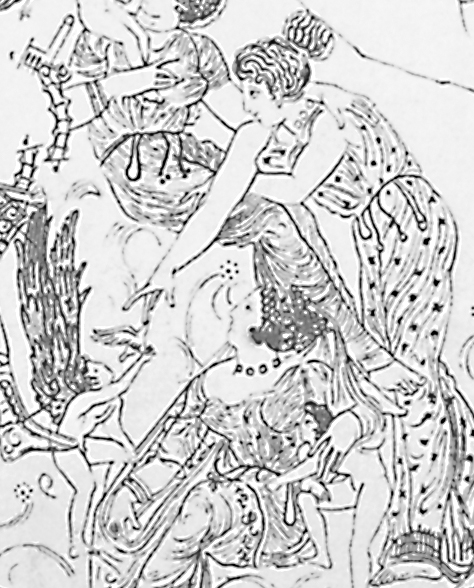
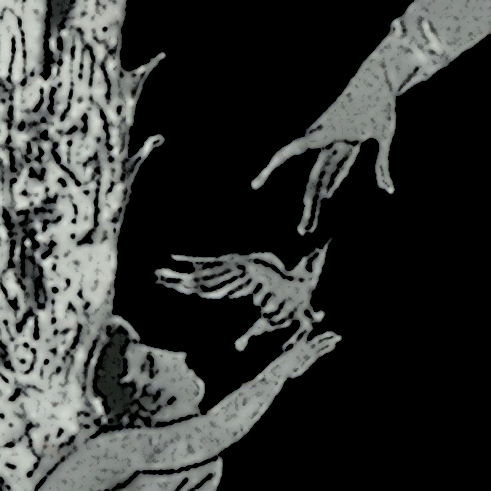
§3. I note a visual choreography of graceful poses in this detail, as the mind’s eye wanders from the delicately posed fingers of a miniature male beauty, who is a cupid, known as Eros in Greek, to the likewise delicately posed fingers of a “life-size” female beauty—here I use the wording “life-size” in contrast with the miniature or “smaller-than-life-size” male beauty. Perched on the index finger of the male beauty Eros, who is of course sexuality personified, is a fluttering small bird who is about to be transferred to the index finger of the female beauty.
§4. There is a comparable visual choreography to be noted, I think, in a detail we saw in another vase painting, as I analyzed it in another previous essay, here, and I now return to that detail. I show it below in the picture on our left, which is paired here with another relevant detail in the picture on our right:

On the right: red-figure calyx krater by the Tithonos Painter; Bochum, Ruhr Universität, Kunstsammlungen, S508. For the overall painting, I cite the Beazley Archive, here. Line-drawing by Jill Robbins.
In the picture on our left, we see a look-alike of Sappho. To be compared, in the picture on our right, on the other hand, is a representation of Sappho herself, and she is actually labeled as Sappho.
§5. In the previous essay that I just cited in §4 about this diptych of pictures representing Sappho herself on our right and a would-be Sappho on our left, I pointed out that the would-be Sappho is shown in the act of gazing intently at a little bird perched on the index finger of her right hand, which is the hand that should be holding the plēktron (plectrum) or ‘twanger’ with which she should be strumming the strings of the lyre that she is fingering in her left hand. I find it most remarkable that the bird is substituted here for the ‘twanger’—especially in view of the fact that we see a reverse substitution in the picturing of another female beauty that is painted on the Thamyris Vase by the Meidias Painter. In this case, we see a female beauty gazing intently not at a little bird perched on the index finger of her right hand but rather at a plēktron (plectrum) or ‘twanger’ that is substituted as the love-object of her gaze. Here is a close-up of this female beauty:
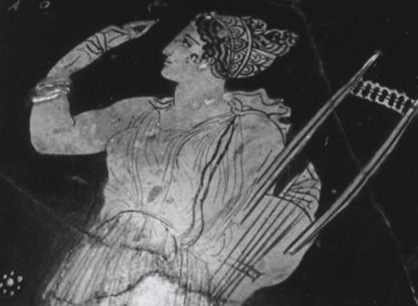
In this case, the holding of the ‘twanger’ in the right hand is to be expected, as we see in this related picture, which is a close-up from another painting:
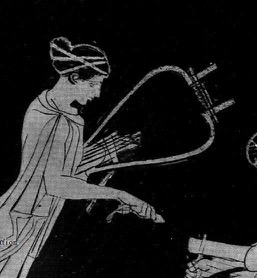
§6. Having shown, then, that the little bird in these classical Athenian vase paintings is connected to the eroticism of songs accompanied by lyres played by female beauties, I am now ready to consider the connectedness of such a bird with the songmaking of Sappho.
§7. Delving into these considerations, I start by reviewing my earlier work on the metaphorical world of birdsong. In my book Poetry as Performance (Nagy 1996), I studied birdsong as a metaphor for poetry, especially poetry that is sung and instrumentally accompanied. I concentrated on the singing of the nightingale, whose song reveals a virtuosity that verges on the celestial in the imagination of poets. But what about a more earthy kind of singing, like the tweeting of, say, a sparrow? This question is relevant to Song 1 of Sappho, the very first song in the ancient canonical collection of her verbal art. As we read at line 10 in that song, birds she calls strouthoi—ordinarily translated as ‘sparrows’—are drawing the celestial chariot of Aphrodite. It is generally assumed that these birds in Song 1 of Sappho, if they really are to be imagined as randy little sparrows, symbolize simply the sexuality of the goddess, but I argue that there is more to it, much more. Yes, the earthiness of Aphrodite’s sexuality could be personified as a sparrow or some other such sexually appetitive little bird. Still, birds and their birdcalls can signal not only an urge to mate but also something higher—which is love, love itself, personified also by Aphrodite. And this kind of love can be made the highest form of love, celestial love, when you sing about it. What you are then singing is a love song, and the beauty of this song must surely give pleasure. If you think of it this way, then the beauty and the pleasure of song can be personified as the ‘sweet bird’ of Milton’s poetry as set to music by Handel, so that the poet’s words are turned into a song that is sung by a warbling soprano who sings to the obbligato accompaniment of a baroque flute. I quote here Milton’s words from Il Penseroso, which the music of Handel has turned into a stylized birdsong:
Sweet bird, that shun’st the noise of folly,
Most musical, most melancholy!
Thee, chauntress, oft the woods among,
I woo to hear thy even-song.
Or, missing thee, I walk unseen,
On the dry smooth-shaven green,
To behold the wand’ring moon
Riding near her highest noon.
And here is a virtuoso performance of Handel’s music:
§8. In this virtuoso performance, I find the body language of the singing Amanda Forsythe and of the accompanying Emi Ferguson evocatively comparable to the imagined singing and self-accompaniment of the female beauties in the classical Athenian paintings that I have considered in this essay. Of course there are contrasts to be noted: in the performance of Handel’s music, the musical instrument is the baroque flute, not the lyre. And the dominant atmosphere of Handel’s music is more pensive than mirthful, whereas the atmosphere of the paintings is more mirthful—at least on the surface. Underneath the surface, however, the paintings, too, hint not only at the joy of love but also at the sorrow of love’s death, especially the sorrow felt over the death of Adonis, look-alike of Eros and boy-lover of Aphrodite. I think that Catullus understood the role of the sweet birds that draw the chariot of Aphrodite in Song 1 of Sappho as a blending of what is Allegro and what is Penseroso, as we see in his Poems 2 and 3 respectively, which convey the essence of his love poetry. I hope to develop this thought in further essays about a girl called Lesbia who loved dearly her playful little pet, her beloved passer or ‘sparrow’ (Nagy 2019.03.08).
§9. And the sparrows—if they are sparrows—that draw the chariot of Aphrodite in Song 1 of Sappho are not only earthy in their eroticism. They are also celestial, since they are sighted in the act of fluttering down from the bright celestial realms up above, coming all the way down to the dark soil of our earthbound existence. In Sappho’s Song 1, the earthy little birds of Aphrodite are analogous to the celestial cupids or Erotes that draw the chariot of Aphrodite in Athenian paintings. They are both the subjects of Sappho’s songmaking and the performers of her songs, becoming thus transformed into the celestial cupids who preoccupy the gaze of female beauty.
§10. To recognize the song, then, is to recognize the singer, the songbird. And yet, as I said at the end of Poetry as Performance (1996:224-225), the singer cannot be independent of the song, as it continues to be performed and re-performed. We may heed the words of Thomas Hardy (1929 [1978]:221), echoing the poems of Wordsworth, Keats, and many others:
The Selfsame Song
A bird sings the selfsame song,
With never a fault in its flow,
That we listened to here those long
Long years ago.
A pleasing marvel is how
A strain of such rapturous rote
Should have gone on thus till now
Unchanged in a note!
—But it’s not the selfsame bird.—
No: perished to dust is he….
As also are those who heard
That song with me.
For bibliographical references, see the dynamic Cumulative Bibliography here.
